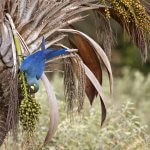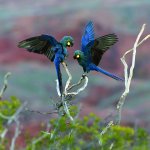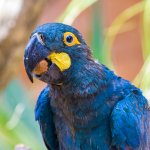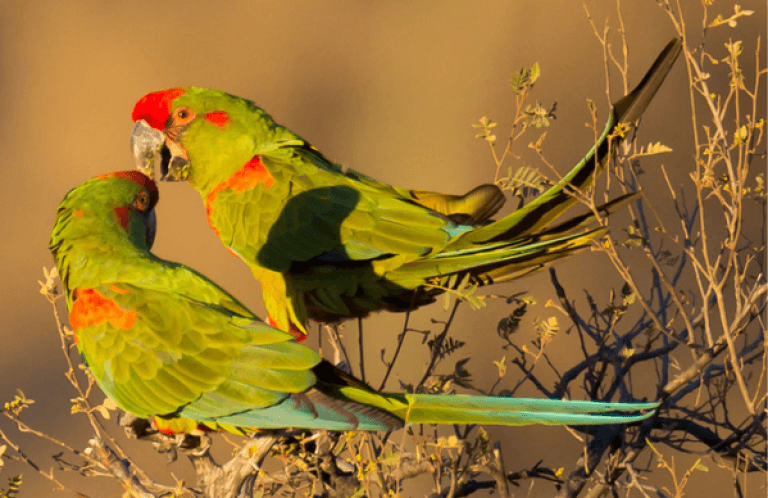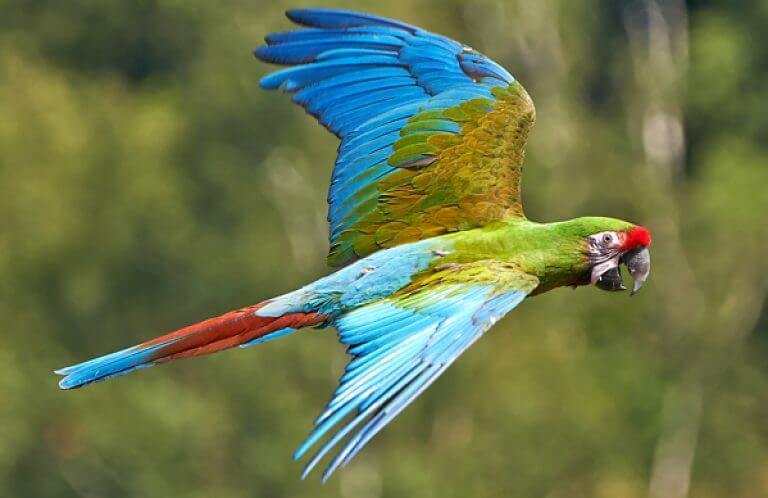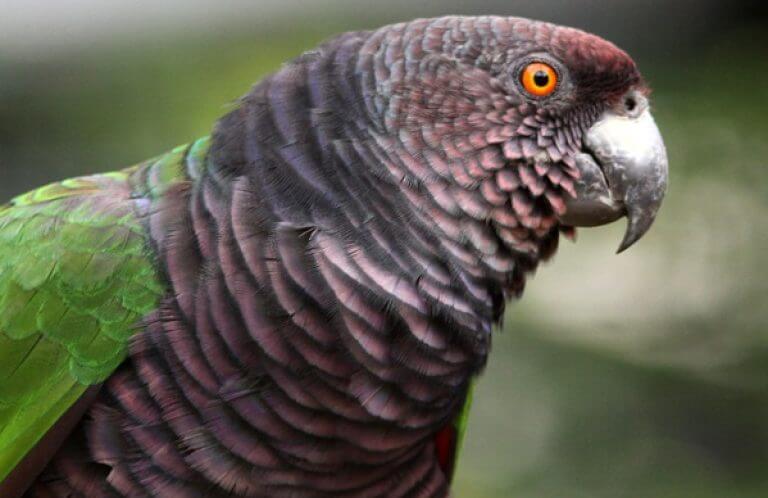About the Lear's Macaw
A flock of Lear's Macaws creates a colorful, noisy splash of blue against red sandstone canyons in eastern Brazil — the only place in the world where these birds can be found.
Large and gregarious, this blue, long-tailed parrot roosts, feeds, and travels in small- to medium-sized flocks, like other members of its family, including the Lilacine Amazon and Red-masked Parakeet.
Although sometimes called the Indigo Macaw, this species' most common name honors British poet, author, and artist Edward Lear.
The Poet and the Parrot
Edward Lear is perhaps most famous for his limericks and nonsense poetry, including children's rhymes such as "The Owl and the Pussycat." As a young man, Lear drew birds and showed such talent that he illustrated and published Illustrations of the Family of Psittacidae, or Parrots before he turned 20. The book was a critical success, and was the first monograph produced in England to focus on a single family of birds.
One of the parrots Lear illustrated caught the eye of French ornithologist Charles Lucien Bonaparte, who formally described it in 1856. But a live specimen of the bird remained elusive until 1978, when ornithologist Helmut Sick located a breeding population of the macaws in Brazil's Bahia state. The rediscovered macaw was then given official species status, along with the name of the young illustrator who had first portrayed it.
Big Blue Macaws
The Lear's Macaw is part of a South American group known as the "blue macaws." Of these, the Spix's Macaw is extinct in the wild (there are approximately 150 captive individuals), and the Glaucous Macaw is likely extinct. The Hyacinth Macaw is the largest parrot in the world and the least-rare blue macaw. Lear's Macaw is similar in appearance to this larger cousin but often has greenish tones to its head and upper back, and sports a yellow, teardrop-shaped patch of facial skin behind its lower mandible, instead of the Hyacinth's thin yellow strip, which runs along the lower mandible's margin.
Songs and Sounds
Like the rest of its family, the Lear's Macaw has an unmelodic voice, emitting a variety of crow-like croaks and screeches, both while perched and in flight.
(Audio: Nick Athanas, XC15579. Accessible at www.xeno-canto.org/15579.)
Breeding and Feeding
Licurí Lover
The bulk of the Lear's Macaw's diet consists of the nuts of the native Licurí Palm – another factor that contributes to the bird's limited distribution. Licurí Palms are often cut down or burned to make way for farm fields, and domestic livestock, especially goats, browse young trees to the ground before they can regrow.
Each Lear's Macaw may eat up to 350 Licurí nuts each day, using its large, strong beak to crack open the hard shells. Other fruits and seeds, agave flowers, and cultivated crops, particularly corn, supplement this bird's diet when palm nuts are scarce. Lear's Macaws are messy eaters, constantly dropping seeds to the ground as they feed in small groups. In this way, the parrots help to sustain the trees they depend upon. Other fruit-eating birds, such as the Keel-billed Toucan and Bearded Bellbird, also "replant" trees in this way while feeding.
Rock-Solid Relationships
Lear's Macaws mate for life, and many pairs stay together for several years before breeding.
Like the Red-fronted Macaw, which inhabits similar arid habitats in Bolivia, the Lear's Macaw roosts and nests in fissures, caves, and cliff-side ledges that riddle sandstone canyons within its range. Groups of Lear's Macaws roost in loose colonies, with three to four birds sharing a space, but during the nesting season mated pairs leave the larger group to set up their nests. A pair will excavate a crevice, or enlarge an existing one, by softening the sandstone with their saliva, then scraping the material away with beaks and feet.
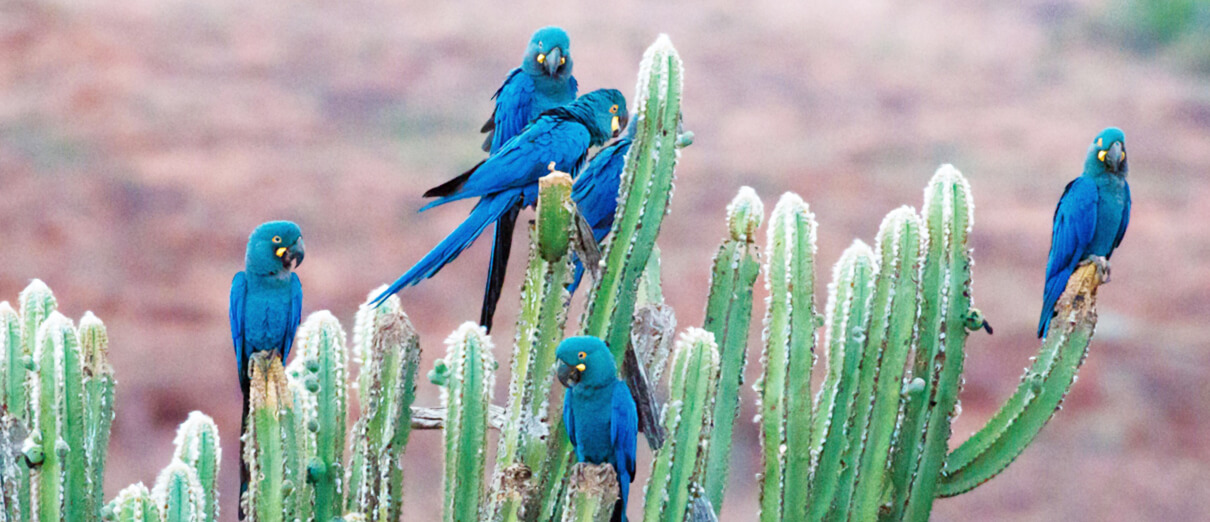
Region and Range
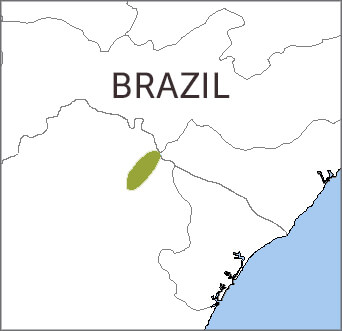
Most of the world's Lear's Macaw population lives at the Canudos Biological Station, with a smaller group about 50 miles away. Because of this extremely limited distribution, the Lear's Macaw is recognized as an Alliance for Zero Extinction (AZE) species. Lear's Macaws remain in their Caatinga habitat year-round.
Conservation
Comeback at Canudos
Habitat loss, hunting, and trapping for the pet trade are ongoing threats to the Lear's Macaw. Like Great Green, Military, and Blue-throated Macaws, these beautiful parrots are sought by poachers fueling the illegal bird trade. Another threat comes from scarcity of the Licurí Palm, a primary food source which, as mentioned previously, is often overgrazed by livestock and cleared to make way for farm fields and pasture.

Help support ABC's conservation mission!
ABC and Brazilian partner Fundação Biodiversitas have played a major role in the Lear's Macaw's comeback. In 2007, the Canudos Biological Station, managed by Biodiversitas, was expanded to 3,649 acres. Two field stations and a lodge have helped to advance study of this bird and other local wildlife and to establish ecotourism there, while keeping poachers away. Birders and other tourists can experience this success story for themselves by visiting Canudos.
Get Involved
Many of the rarest bird species in the Western Hemisphere remain relatively unknown. You can learn more about these birds and the threats they face by signing up for ABC's Bird of the Week email series, which frequently highlights these fascinating birds.
American Bird Conservancy and our partners throughout Latin America and the Caribbean have created and expanded more than 100 bird reserves, which protect upward of 1.1 million acres of vital habitat. Together, we've planted more than 6.8 million trees, helping to restore degraded and damaged habitat. You can help us continue to protect endangered birds by making a gift today.






































